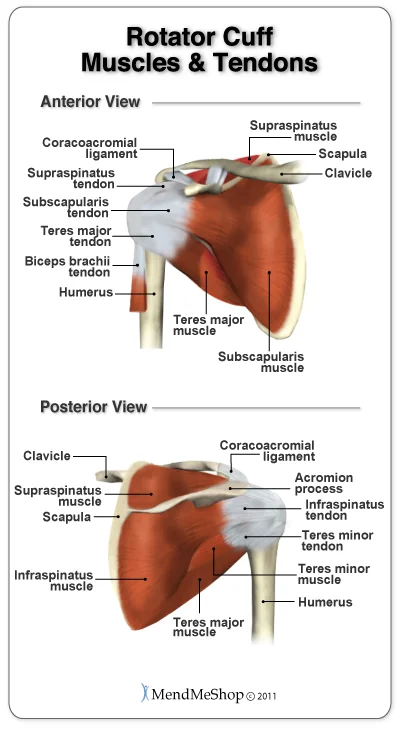The rotator cuff is made up of four major muscles and their tendons: supraspinatus, infraspinatus, teres minor, and the subscapularis. These muscles:
· Are used to generate torque for shoulder movement
· Act as dynamic stabilizers of the shoulder joint
· Help to lower and provide stability to the humeral head (the end of your arm bone) that fits into the shoulder joint
Rotator Cuff (Shoulder) injuries can be caused by a variety of factors, including acute trauma, repetitive motions and muscle imbalances. In most cases of Rotator Cuff Tendonitis or Tendonopathy, the muscle has sustained micro-tears as a result of repetitive strain and over use. This is known as a Repetitive Strain Injury (RSI). Rotator Cuff Injuries are commonly found in repetitive overhead activities like tennis, pickleball, swimming, paddling, baseball and house cleaning.
Our bodies are amazing at adaptation and so, to compensate for the stresses placed upon our muscles and joints, the body lays down fibrous adhesions between the muscles. We call these fibrous adhesions ‘scar tissue’.
This scar tissue is less stretchy and more fibrous than normal tissue and causes the muscles to gradually lose their ability to stretch. This, in turn, leads to weaker muscles that become more prone to injury. These scar tissue adhesions also restrict the muscles ability to slide freely past one another resulting in a disruption of proper biomechanics at the joint. Shortened muscles and tightened joints combine to impair coordination and reduce power – leading to further injuries. We call this the Cumulative Injury Cycle.
So what can you do about it?
Rotator Cuff injuries are traditionally treated with anti-inflammatories, ice, rest, stretching, electric modalities, exercises, surgery, steroid injections and ultrasound with varying results. There can be problems that often accompany these traditional treatments. Repeated use of steroids weakens tendons, which results in further biomechanical imbalances in the shoulder. Most traditional treatments provide only symptomatic relief from the pain and do not remove the restrictive adhesions that are the true cause of the problem. This means that while you might feel better in the short term, your rotator cuff pain is likely to return. This is where Active Release Techniques can really shine.
Active Release Techniques (ART) is a hands-on soft-tissue (muscles, tendons, ligaments, nerves) technique that is based on a strong understanding of anatomy, physiology and biomechanics. ART alters the tissue structure by breaking up scar tissue adhesions and restoring normal function to the affected areas.
ART treatments typically last about 15 -30 minutes depending on the number of areas of being treated and involve the practitioner using hand and thumb pressure over the area’s affected by scar tissue to break up the adhesions. This aids in restoring the muscle’s ability to stretch and glide resulting in healthier muscle tissue and a return to proper joint mechanics. For complete rehabilitation of the shoulder, once the adhesions have been removed, your health practitioner will prescribe specific exercises to strengthen the rotator cuff and restore proper muscle balance.
Synergy Health and Wellness Centre is one of the few clinics in Collingwood that offers ART treatments. Our Chiropractor, Dr. Laura Clemenhagen, would be happy to speak with you about whether ART would be a good treatment option for you.
